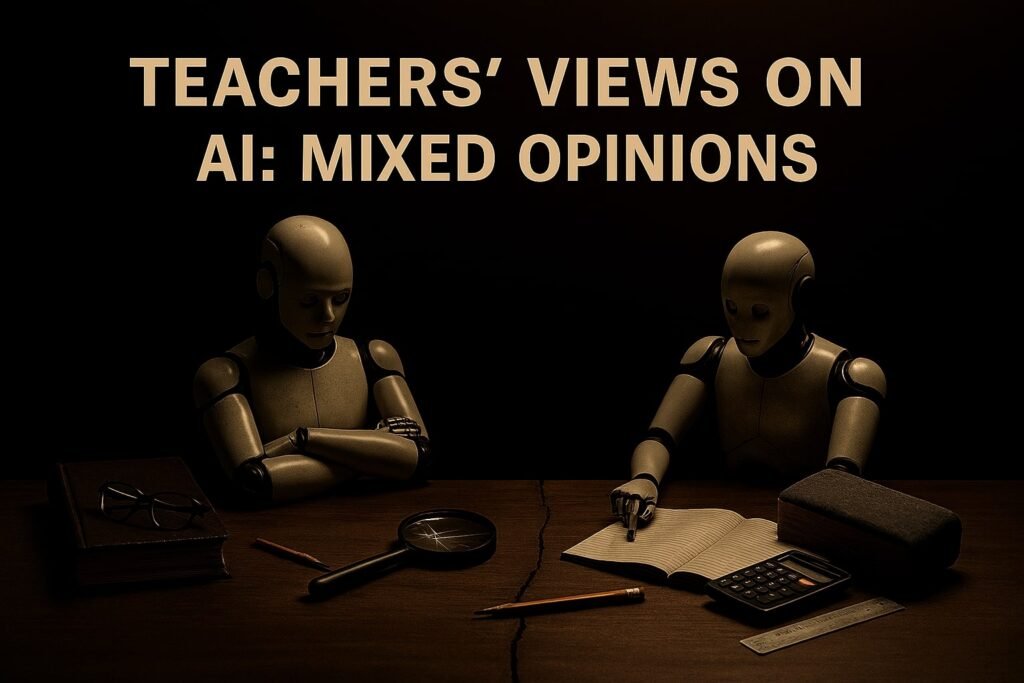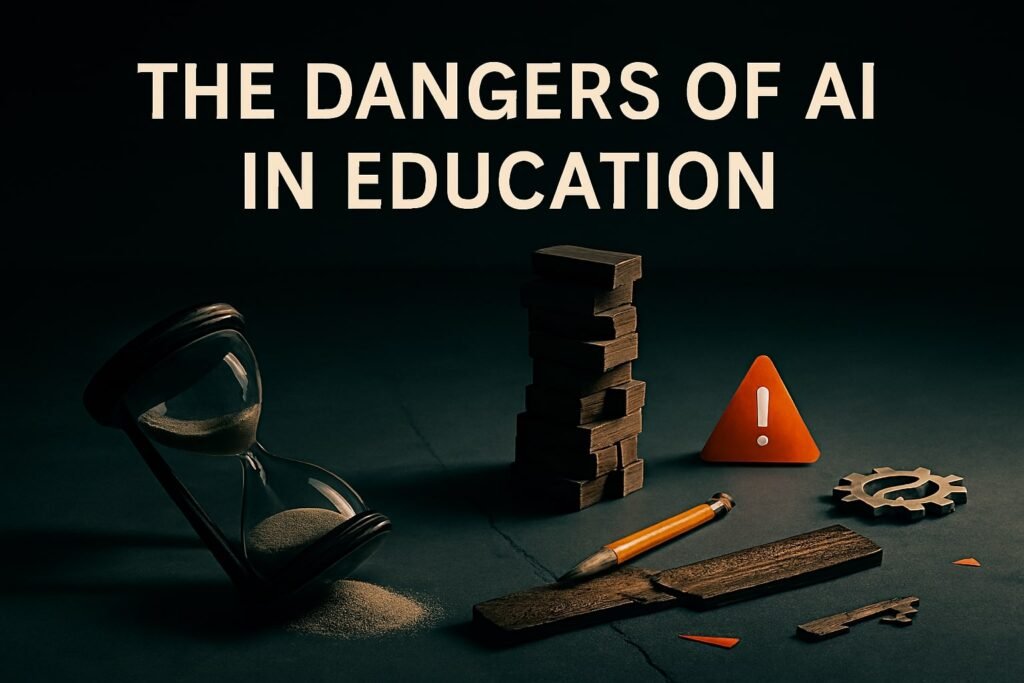Artificial intelligence (AI) is changing classrooms fast. Some say it makes students smarter. Others say it makes school too easy. Generative AI—tools like chatbots that write, solve problems, or create essays—is everywhere. While AI brings exciting chances to learn, there are real dangers of AI in education. These risks go beyond cheating. They include false information, dependence on machines, and even a loss of grit.
This article explains these dangers using real examples, surveys, and expert opinions. It will help parents, teachers, and students understand what AI can—and cannot—do in schools.
What Are the Main Dangers of AI in Education?
AI in schools can help students and teachers. But it also comes with big risks. The main dangers include:
- Cheating: Students can use AI to do homework or write essays without learning.
- Hallucinations: AI sometimes makes up facts or sources.
- Over-reliance: Students may depend on AI too much, weakening thinking skills.
- Loss of grit: Struggle builds resilience. AI may take that struggle away.
Teachers are divided. Some see AI as harmful. Others see it as a tool to improve learning. But data shows AI is already everywhere in schools. Using it responsibly is urgent.

How Students Accidentally Reveal AI Use
Students often don’t realize when AI leaves clues in their work. A common example is phrases like:
“I hope this is helpful to you.”
A teacher reading this might wonder why a student would write that in a school assignment. It signals that the work came directly from AI. Teachers worldwide report similar mistakes. Students are using AI more than they know, often without editing its output.
What the Data Says About AI in Classrooms
Surveys and research show AI use is widespread:
- Digital Education Council (2024): 86% of college students use AI, 54% use it weekly.
- ACT (2023): About 50% of high school students reported using AI tools.
- Turnitin (2023–2024): Of 200 million papers, 11% had at least 20% AI-generated content. Three percent were nearly fully AI-written.
- Titan Partners & Study.com (2024): Many teachers now use AI for lesson planning and class materials.
AI isn’t a side tool anymore. It is central to the learning process.
Teachers’ Views on AI: Mixed Opinions
Teachers have different opinions about AI in education:
- Against AI: Robert Gell, from the University of Calgary, calls AI “destructive” to critical thinking. He compares it to “asking a robot to lift weights for you.” His worry: students lose the effort needed to build strong ideas.
- Adapting to AI: Ben Pythri, a statistics professor, moved writing assignments into class. This way, students still show original thought while using AI outside class.
This split shows the tension: Should schools ban, adapt, or fully embrace AI?

The Dangers of AI Hallucinations
AI doesn’t always tell the truth. It can hallucinate, which means it makes up information. Examples include:
- Fake book titles or citations.
- False historical facts.
- Strange claims, like “Prophet Moses got chocolate stains out of t-shirts.”
The danger is not just misinformation. Students may accept these errors as true. Without questioning AI, learners risk learning wrong facts.
How Teachers Are Using AI
Teachers also use AI to help them teach:
- Creating lesson plans and schedules.
- Generating quizzes or worksheets.
- Making AI-written example essays for students.
While AI saves time, it can make teaching feel repetitive. If AI decides the “correct way” to do something, students may lose creativity.
Could AI-Run Schools Be the Future?
Some schools already use AI for part of their lessons. Students spend a few hours a day learning from AI. The rest of the day is for projects, physical activity, or life skills. Early reports show high grades and test scores in the 90th percentile.
But questions remain. Will students succeed in college or work without AI help? Or will they struggle when AI is not there to scaffold their learning?
The Biggest Danger: Losing Grit
Cheating and hallucinations are serious. But the deeper danger is losing grit. Grit is the effort, perseverance, and resilience students develop when facing challenges. AI can make learning easier. But if students don’t struggle, they miss growth.
Over time, this could create a generation that is technically skilled but less able to solve problems independently.
Benefits of AI in Education
AI is not all bad. Some benefits include:
- Saves teachers time for planning and grading.
- Gives students instant feedback.
- Helps schools with fewer resources access advanced tutoring.
- Encourages creativity and brainstorming.
Areas of Concern
Even with benefits, concerns remain:
- Risk of plagiarism or over-dependence.
- Weakened problem-solving and creativity.
- Spread of false information.
- Loss of teacher and student originality.
- Reduced grit and resilience in students.
Comparison Table: Benefits vs. Dangers
| Aspect | Benefits | Dangers |
| Access to resources | Equalizes tutoring and support | Over-reliance on AI answers |
| Teacher support | Saves time on admin tasks | Loss of teacher creativity |
| Student experience | Personalized learning | Risk of cheating |
| Knowledge accuracy | Fast explanations | Hallucinations (fake info) |
| Skill development | Encourages brainstorming | Weakens problem-solving and grit |
FAQs About AI in Education
1. Can AI detect cheating?
Tools like Turnitin try, but detection is inconsistent. AI work can slip through.
2. What is the biggest risk?
Losing grit—the ability to struggle, solve problems, and grow.
3. How do teachers adapt?
Some move assignments into class. Others ban AI entirely.
4. Are AI hallucinations common?
Yes. Chatbots often make up facts, citations, and strange claims.
5. Will AI replace teachers?
No. AI can teach some subjects, but teachers guide emotional, social, and life skills.
6. Should parents worry?
Yes, if kids use AI as a shortcut. Responsible use can support learning.
7. How can schools manage AI responsibly?
Teach AI literacy and use a mix of AI-assisted and in-class assignments.
Conclusion
AI is here to stay. Its dangers in education are real: cheating, hallucinations, dependence, and loss of grit. But AI also brings opportunities: faster feedback, personalized learning, and creativity.
The key is balance. Students must learn when to use AI and when to rely on their own skills. If schools manage it right, AI can enhance learning instead of replacing effort.
Author Bio
This article was written by an education and technology researcher. They focus on how AI intersects with learning, teaching, and ethics. With experience analyzing digital learning trends and working with teachers, they provide a clear, balanced view of AI in classrooms.
References
- Digital Education Council (2024) Survey Report.
- ACT (2023) Student AI Use in High Schools.
- Turnitin (2023–2024) AI Detection Data.
- Titan Partners & Study.com (2024) Teacher AI Usage Reports.
- Gell, R. (University of Calgary) – Expert Opinion.
- Pythri, B. – Case Study on AI-Adaptive Teaching.


